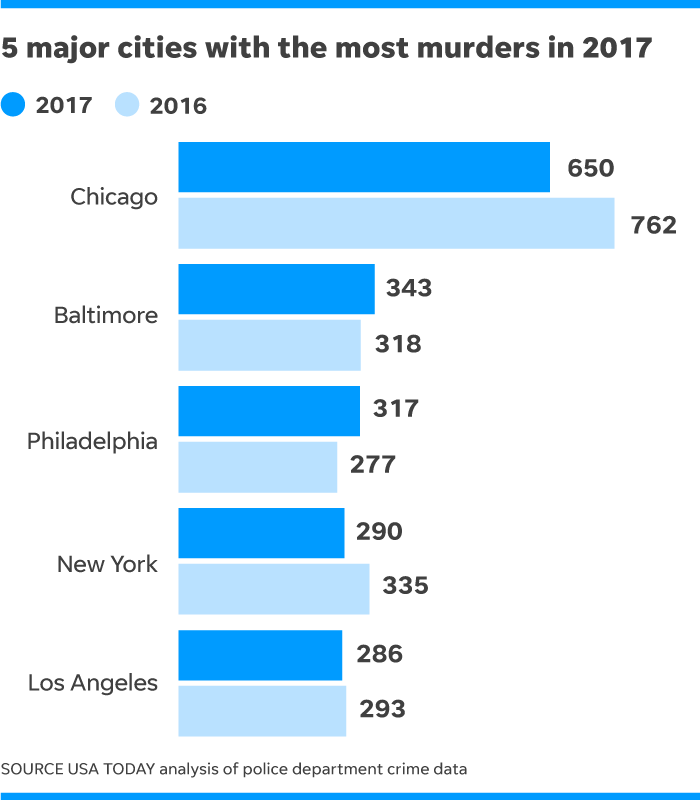Baltimore is the nation's most dangerous big city
 Aamer Madhani
Aamer Madhani
The collective homicide toll for America’s 50 biggest cities dipped slightly in 2017, a USA TODAY analysis of crime data found.
The FBI won’t publish its annual comprehensive crime report until later this year, but an early review of police department crime data shows that killings decreased by at least 1% in large jurisdictions compared with 2016.
The modest decrease in killings comes after FBI data showed back-to-back years in which homicides rose sharply in large cities. (Homicides in cities with 250,000 or more residents rose by about 15.2% from 2014 to 2015, and 8.2% from 2015 to 2016.)
There were 5,738 homicides in the nation’s 50 biggest cities in 2017 compared with 5,863 homicides in 2016, a roughly 2.3% reduction.
Las Vegas Police reported 141 homicides for 2017 in its official tally but did not include the Oct. 1 mass shooting at an outdoor country music concert that left 58 dead. If those deaths were included in the department's tally, the national big city homicide toll fell by 1.1%, the USA TODAY review found.
Even with the sharp rise in homicides in the two years prior to 2017, the national murder toll continued to hover near historic lows.
The national decrease in killings in 2017 was largely driven by double-digit percentage dips in some of the nation’s biggest cities, including Chicago (14.7%), New York City (13.4%) and Houston (11%). In fact, the New York Police Department reported that its annual murder tally fell below 300 for the first time and the city notched its lowest per capita murder rate in nearly 70 years.

More:Chicago ends 2017 with 650 murders, a grim sign of improvement
More:Opioids are adding a dangerous wrinkle to violent cities
More:FBI: Violent crime increases for second straight year
New York, which hit its nadir in the midst of the crack-cocaine epidemic when it tallied more than 2,200 murders in 1990, boasts that the nation’s largest city is now the safest it’s been since the Dodgers played in Brooklyn and a pizza slice set you back 15 cents.
While New York and others boasted of significant progress, other large cities saw a big surge in killings in 2017.
Baltimore is the big city with the highest per capita murder rate in the nation, with nearly 56 murders per 100,000 people. At 343 murders in 2017, the city tallied the highest per capita rate in its history. Columbus tallied 143 murders — 37 more than 2016 and the most the city has seen in a single year.
In both cities, officials blamed the rise in homicides on gangs and drug activity.
“In New York, they concentrated on the right neighborhoods, they’ve invested well in predictive analytics and technology,” said Peter Scharf, a criminologist at the LSU School of Public Health and Justice. “The other part of what we’re seeing nationally might be a story of haves and have-nots. While some departments have made the investments, other police departments are still in the backwater of policing.”
Chicago saw its murder tally dip to 650 in 2017 from 762 in the prior year. The murder toll remains high in the Windy City — near levels of violence the city endured in the late 1990s — but police officials there say they believe investments in technology are beginning to help officers stem the violence.
Dozens of chiefs and senior police officials from departments across the country gathered in Chicago late last month to trade notes on how to best use technology in the crime fight.
Chicago Police Superintendent Eddie Johnson said investments in technology are undoubtedly paying off. But his city’s department, like many others, will also have to continue to focus on improving relations with residents to further reduce the homicide toll, he said.
Chicago is one of many big departments that has seen its relationship strained in poor and minority communities in the aftermath of a series of controversial police-involved shootings across the country in recent years.
Some crime experts and law enforcement officials believe the fractured relationships could have had some impact on driving homicide rates in jurisdictions, such as Chicago and Baltimore, in recent years.
"We have an obligation and responsibility to keep our jurisdictions as safe as we can. The one way we really get to it is to have a collaborative effort," Johnson said. "You just can’t have law enforcement as the only entity out there trying to reduce crime. The partnerships you build with the community are paramount to reducing crime. I don’t care what jurisdiction you’re in.”
@AamerISmad